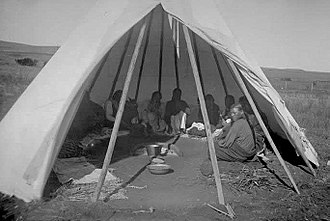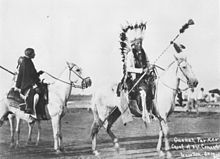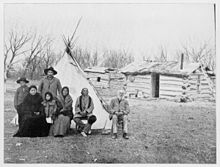Native American Church
The Native American Church (NAC) is now the largest denomination of North American Indians . The central element is the ritual enjoyment of the peyote cactus , which, among other things, contains the psychoactive drug mescaline . The effects are varied and range from disinhibition to hallucinations and states of fear. Used in a religious context, peyote leads to spiritual experiences (see also: Entheogen ) . Because of this, the belief of the NAC members is also known as peyotism or peyote religion .
The term church is misleading as it does not represent a Christian denomination . Rather, the Native American Church emerged from a syncretistic mixture of various traditional Indian religions and Christianity brought with them by European settlers to form a neo-ethnic religion .
Since peyotism has no fixed doctrine or doctrine , very different views have sometimes been established in the various groups. As a rule, there is a belief in a supreme God, who is called "Great Spirit" and who is sometimes more Christian, sometimes more traditional (see for example: Wakan , Manitu or Orenda ) . It communicates itself to man through various spirits; such as the traditional thunderbird , which brings the prayers of believers to God. Often the peyote is viewed as an animated spirit, which is considered to represent God or is identified with Jesus. In some tribes, Jesus is seen as an Indian cultural hero , as an intercessor with God or as a protective spirit who turns to the Indians killed by whites.
Peyote - eaten in a ritual context - enables the individual to connect with God and the spirits (including the ancestors); Receiving visions , spiritual power, moral guidance, or healing.
The nightly ritual, which is accompanied by rattles and drums, usually takes place in a tipi around a crescent-shaped earth altar and a sacred fire. The so-called “All-Night-Ceremony” usually begins around 8 p.m. on Saturdays and is led by a “Peyote chief”. People pray, sing, meditate, eat peyote and drink holy water. In addition, such water and tobacco are sacrificed to mother earth . The conclusion is a joint breakfast on Sunday morning.
The life path of a follower of the NAC is called “Peyote Road” and demands brotherly love, family care, self-help through constant work, renouncing alcohol and violence, monogamy and absolute honesty. In addition, witchcraft and magical practices are prohibited.
Peyotism originated around 1885 among the Kiowa and Comanche in Oklahoma. Despite considerable opposition, the Native American Church of the USA was founded in 1918 as a formal superstructure. In 1954, the NAC of Canada was created. The peyote religion is one of the most influential instances for modern Pan -Indianism (cross-tribal self-confidence as "Indians") and is represented today in more than 50 tribes. Since the NAC has no official members, the figures for 100,000 to 225,000 members (1992) are based on estimates.
history
Origins of peyote use
Peyote was already used by the Aztecs in pre-Columbian times in the area of today's Mexico for communication with the supernatural (securing field fertility, hunting success or the luck of war), but also for fighting hunger, thirst and fatigue as well as in medicine . The cactus is still used traditionally by the Mexican peoples of the Tarahumara and the Huichol . But peyote and its effects were known much earlier. This is proven by finds of Central American grave figures from around 200 BC.
Early integration of the peyote ritual into different religions
The Karankawa , Tonkawa , and Lipan-Apache tribes adopted the use of peyote by the Carrizo - who lived in the region between Laredo and the Gulf of Mexico - in their traditional religions by 1870 at the latest . Assuming that the Carrizo are the Coahuiltecan of the Spanish sources, the description of a peyote ritual from 1649 by Alonso de León refers to the ancestors of the group later known as Carrizo, whose self-name was lost. According to the Lipan tradition, the Tonkawa were the first North American Indian tribe to practice the peyote ritual (see web links Opler). The next group, the Lipan, were first mentioned in 1757. They fled the Comanche to the peyote region before 1830. The Karankawa became followers of the peyote cult before the Tonkawa. However, the time of the first appearance of this rite in this tribe is controversial. However, it can be assumed that the Karankawa practiced the peyote cult as early as the 18th century. Eventually the Caddo learned the use of peyote through the Tonkawa. Mooney believed that the Mescaleros brought the peyote rituals north, but it was probably the Lipan who took them over from the Carrizo around 1850 and brought them to the tribes in US territory.
Development of the independent peyote religion and the Christian influence
The ritual continued to spread from the aforementioned tribes - especially the Tonkawa. The move to the independent religion of peyotism took place around 1885 among the Comanche and Kiowa in western Oklahoma, who had recently been assigned to reservations. This marked the end of their hunting lifestyle and led to a severe existential crisis. The new ritual - which was first used to heal the sick and acquire spiritual powers - quickly became an important new social tool.
The new cult with the “spiritual drug” quickly found many followers among the tribes of central and western North America, because it offered a possibility to continue to carry out the ritual of the search for a vision , which is central for these peoples, in a modified form and created a new cross-tribal identification. The sedentary life in the reserves, the cultural uprooting and the strong acculturation pressure from the Euro-American majority society made the search for visions in the wilderness, full of privation, increasingly rare. The rapid spread of the ceremony and the peyote (the cactus grows between central Mexico and south Texas) in the late 19th and early 20th centuries came about through so-called "road men" who traveled from tribe to tribe.
Over time, the ritual changed due to the increasing Christian influence. It was increasingly marked by Catholic-inspired moderation and withdrawal from the family. At the same time, the contacts and trade relationships promoted by the mission stations also facilitated the trade in the coveted substance.
The chief Quanah Parker (Comanche), the medicine man John Wilson (Caddo), and the Lipan Apache Chevato (also known as Chebahtah after being adopted by Quanah Parker) were instrumental in the rapid spread of peyote use among the prairie after 1890. and Plains Indians, involved in the Southwest and the Great Lakes. Their work was also a decisive prerequisite for the founding of the Native American Church in 1918. At that time, the peyote cult had already been supplemented by numerous Christian beliefs and ritual elements. In 1899 the Oklahoma Territory was the first of 15 states to forbid the use of peyote, but in 1914 the "firstborn church of Jesus Christ" was founded and in 1918 the first "Native American Church". After 1934 the bans were reversed.
Development of the Native American Church
The first mention of the name Native American Church is unclear. Some sources speak of 1870, others of 1890. Since at the turn of the 20th century the “Christian part of the faith” already predominated in many groups, it is not surprising that the Native American Church was based on the Christian church order. Nevertheless, the peyote religion is less an Indian version of Christianity than a nativist reaction to Christianity, which is rejected by both the established churches and the followers of the traditional religions.
However, this had no negative impact on the "triumphant advance" of the new Indian religion: in the 1930s around 50 percent of the American Indians belonged to the Native American Church. It still plays a central role in the Pan-Indian movement today.
The Navajo (Diné), who were able to preserve their independent culture as nomadic shepherds and their religious traditions for a very long time, only became increasingly peyotists in the 1930s - after the forced reduction of their herds. In 1940 the religion was banned by the Diné tribal council because it saw it as a threat to both their culture and the Christian Diné. The peyote religion was then only practiced illegally in the underground until the ban was lifted again in 1967. Other peoples who still had functional traditional religions - such as the Iroquois , the Pueblo cultures or the Anishinabe - were largely "immune" to the new religion for a long time.
In 1960 there were branches of the NAC in 11 states. In the 1960s, anthropologists and human rights groups supported recognition of these groups.
In 1970, the use of peyote in religious ceremonies was legalized by the US government. However, a ruling by the Supreme Court in 1990 left the states free to ban peyote completely. Many Indians see this judgment as a restriction of their religious freedom .
In all of the bans on the peyote religion, allegations of drug use played an important role. Although the consumption of the peyote cactus can lead to serious psychological side effects, the active ingredient mescaline is not addictive and does not lead to health problems even after prolonged (moderate) use.
Diversity of beliefs, worldview and recognition
The beliefs of the followers of the Native American Church vary from tribe to tribe.
Some of the most common variants are:
- belief in Jesus as the native American hero , advocate or spiritual guardian of humanity,
- belief in the bible ,
- the belief in peyote as the personification of God ,
- the connection of Jesus with peyote.
The Christian influence, which today mostly predominates or has even fully established itself, expresses itself in very different ways. The Winnebago, for example, equate the master of ceremonies, the drummer and the so-called "cedar man" with father, son and holy spirit. The Kiowa decorate the water bucket with cross symbols in the rite and the Cheyenne carve prayers to Jesus into their cult objects. For them, the Bible is an accessory to the cult and on special occasions passages of text are read from the scriptures. In some peyote communities, Christian or at least Christian influenced songs are sung in some ceremonies.
The followers of the NAC believe that the ritual and the community help them to come into harmony with their life and God and to be able to find themselves. This should give them strength in everyday life. A good person is considered to be someone who acts in a friendly, fraternal, responsible, and above all with love. The church has a very strong communal character. Many members join the Church when their lives are threatened by substance abuse. It should give them strength to distance themselves from it.
This view of peyote as a cure for alcoholism and other societal illnesses is one reason why federal and many state laws privilege members of the Native American Church. They are not prosecuted for substance abuse like other peyote and mescaline users . Only members of registered Indian tribes are allowed to join the church; membership is denied to people of other origins.
literature
- Martin Gusinde : The Peyote Cult . In: St. Gabriel-Festschrift , Vienna-Mödling, 1939, pp. 401–499.
- Weston La Barre : The Peyote Cult , New Haven, 1938. 2nd ed .: Hamden, Conn., 1964.
- JS Slotkin: The Peyote Religion , Glencoe, Ill., 1956
- Tony Hillerman : The Death of the Moles (Fiction), 1980
- Beatriz Caiuby Labate, Clancy Cavnar: Peyote. History, Tradition, Politics, and Conversation , Praeger, 2016. ISBN 9781440834004
- Omer C. Stewart: Peyote Religion: A history . ( The Civilization of the American Indian Series 181) 1987 ( digitized version )
- items
- Friedrich Abel: Peyote: The sacred drug. In: Geo-Magazin. Hamburg 1980,7, SS 8-36. Informative experience report: "Navajos have revived an ancient cult of the Aztecs". ISSN 0342-8311
Web links
- Morris Edward Opler: THE USE OF PEYOTE BY THE CARRIZO AND LIPAN APACHE TRIBES
- Morris Edward Opler: A DESCRIPTION OF A TONKAWA PEYOTE MEETING HELD IN 1902
Individual evidence
- ↑ a b c d e f g h i Christian F. Feest : Animated Worlds - The religions of the Indians of North America. In: Small Library of Religions , Vol. 9, Herder, Freiburg / Basel / Vienna 1998, ISBN 3-451-23849-7 . Pp. 200-203.
- ↑ a b c d e f g Keyword: Native American Church in the Encyclopedia Britannica, accessed January 12, 2016.
- ↑ a b Thomas Jeier: The first Americans. A story of the Indians. 1st edition, DVA, Munich 2011 eISBN 978-3-641-06592-8. Chapter 8.
- ↑ a b philtar.ac.uk : Overview of World Religions: Native American Church , accessed on January 12, 2016.
- ↑ a b c d e Othmar Noggler: Indian, published in: Horst Balz et al. (Ed.): Theologische Realenzyklopädie , Volume 16: "Idealism - Jesus Christ IV". Walter de Gruyter, Berlin, New York 1987, ISBN 978-3-11-019098-4 . S. Horst Balz et al. (Ed.): Theologische Realenzyklopädie , Volume 16: "Idealism - Jesus Christ IV". Walter de Gruyter, Berlin, New York 1987, ISBN 978-3-11-019098-4 . Pp. 97-102.
- ↑ a b c d Walter Hirschberg (Gre.), Wolfgang Müller (Red.): Dictionary of Ethnology. New edition, 2nd edition, Reimer, Berlin 2005. pp. 286–287.
- ↑ a b c d Omer Call Stewart: Peyote Religion. A History , University of Oklahoma Press 1987, pp. 46, 47-52.
- ^ A b Carl Waldman: Encyclopedia of Native American Tribes. Revised edition. Checkmark, New York NY 1999, ISBN 0-8160-3964-X . Pp. 77-78.
- ^ DE Nichols: Hallucinogens . (PDF) In: Pharmacology & therapeutics. Volume 101, Number 2, February 2004, pp. 131-181, doi: 10.1016 / j.pharmthera.2003.11.002 . PMID 14761703 . (Review).
- ↑ National Institute on Drug Abuse: InfoFacts: Hallucinogens - LSD, Peyote, Psilocybin, and PCP.
- ^ Peyote: History, Traditions, Politics






